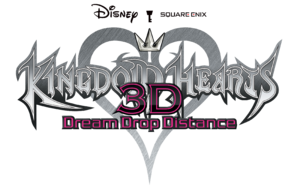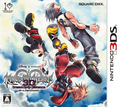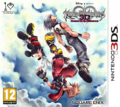Kingdom Hearts 3D: Dream Drop Distance: Difference between revisions
EnglishJoker (talk | contribs) (→Video: I think the trailers can go now that the game's out. They're all on YouTube anyway.) |
EnglishJoker (talk | contribs) (→Development: Changed the development from "timeline" to "production".) |
||
| Line 150: | Line 150: | ||
==Development== | ==Development== | ||
The game | The game's title was used to reference its various themes, with "Dream" referencing the storyline and "Drop" the gameplay style. Although Tetsuya Nomura admitted the English used was not grammatically correct, the team still decided to use it based on the way it sounded. One of the team's desires with the game was for it to have more action than the previous games. Nomura noted the ties the gameplay changes had with the gameplay from ''[[Final Fantasy Versus XIII]]'' as a result of their similar styles. The new maneuvers employed in the ''Dream Drop Distance'' are also meant to give a glimpse about how the next game in the series, ''[[Kingdom Hearts III]]'', will look like. New worlds were included in the game as a result of multiple requests by fans.<ref name="discussion" /> The switches between player character Sora and Riku across the game are meant to contrast the style from ''Kingdom Hearts Birth By Sleep'', which allowed the player to use three characters in their own campaigns.<ref>{{cite web |url=http://andriasang.com/comtfs/kingdom_hearts_3ds_detailed/|title=Kingdom Hearts 3DS Named, Trailered and Discussed|author=Gantayat, Anoop |date=January 19, 2011 |publisher=Andriasang |accessdate=April 7, 2012}}</ref> | ||
With ''Kingdom Hearts Re:coded'', the staff revealed that ''Kingdom Hearts 3D'' would revolved around Sora's and Riku's Mark of the Mastery exam, but were worried about how to set it. The idea of Sora going through a dream was inspired by the subtitle of ''Kingdom Hearts: Birth by Sleep'' and served as a basis for the game.<ref>{{cite web |url=http://www.siliconera.com/2012/03/23/nomura-explains-kingdom-hearts-3d-dream-drop-distances-title/|title=Nomura Explains Kingdom Hearts 3D: Dream Drop Distance’s Title|author=|date=March 23, 2012 |publisher=Siliconera|accessdate=April 12, 2012}}</ref> As a result of the game's plot, both Sora and Riku appear in their younger forms from the first ''[[Kingdom Hearts (video game)|Kingdom Hearts]]'' game. However, to avoid misconceptions that ''Kingdom Hearts 3D'' was a remake of the original game, Nomura decided to change Sora's and Riku's outfits for most of the game.<ref>{{cite web |url=http://andriasang.com/comtqe/kh3d_sora_riku_clothes/|title=Kingdom Hearts 3D: Sora and Riku to See Clothing Changes|author=Gantayat, Anoop |date=January 30, 2011 |publisher=Andriasang |accessdate=April 12, 2012}}</ref> Nomura also anticipated the longest cutscene from the entire series as he wanted to reveal the intentions from the antagonists Xemnas and Ansem, also emphasizing the importance of Axel and the young Xehanort, unidentified by that of the announcement, in the story.<ref>{{cite web |url=http://www.siliconera.com/2012/03/17/many-truths-will-be-revealed-at-the-end-of-kingdom-hearts-3d/|title=Many Truths Will Be Revealed At The End Of Kingdom Hearts 3D|author=|date=March 27, 2012 |publisher=Siliconera|accessdate=April 12, 2012}}</ref> | |||
The game was announced at the [[Electronic Entertainment Expo 2010]] as "Kingdom Hearts 3D Demo" for the Nintendo 3DS.<ref name="Nomura">{{cite web |url=http://www.andriasang.com/e/blog/2010/06/18/nomura_on_kh_3d is/ |title=Tetsuya Nomura on Kingdom Hearts 3D |author=Gantayat, Anoop |date=June 18, 2010 |work= |publisher=Andriasang |accessdate=June 16, 2010}}</ref> It was formally unveiled though at the Square Enix 1st Production Department Premier event at the Toho Cinemas in Tokyo, Japan on January 18, 2011 with its first trailer along with its official name.<ref name="JanAnnouncement">{{cite web |url=http://www.andriasang.com/e/blog/2011/01/18/square_enix_teaser_sites/ |title=Square Enix Opens Teaser Sites for New Games |author=Anoop Gantayat |date=January 18, 2011 |work= |publisher=Andriasang |accessdate=January 17, 2011}}</ref> During the game's development, series creator Tetsuya Nomura emphasized the mystery element of the story and confirmed that the theme of the game is trust.<ref name="Nomura"/> In July 2011, a ''Famitsu'' article included a interview with Nomura in which he revealed that the game would have an unlockable secret movie. A playable demo released the same month also first featured the Dream Eaters as the player characters' partners and the game's generic enemy.<ref>{{cite web|url=http://www.andriasang.com/e/blog/2011/07/13/famitsu_squenix_feature/|title=Kingdom Hearts 3D, Final Fantasy XI, Dissidia and More in Famitsu|author=Gantayat, Anoop|publisher=Andriasang|date=July 13, 2011|accessdate=April 6, 2012}}</ref> A ''Dengeki'' issue featured another interview with Nomura, where he confirmed that he would be considering what he called a "HD Technical Test" in order to commemorate the series' tenth anniversary and to entice players new to the series.<ref name="andriasang" /> This occurred on March 3, 2012 in the form of an premiere event where footage from the game, including its full CGI introduction sequence, was showcased to celebrate the game's release.<ref>{{cite web|url=http://www.animenewsnetwork.com/interest/2012-03-23/kingdom-hearts-3d-game-premiere-light-show-streamed|title=Kingdom Hearts 3D Game's Premiere Light Show Streamed|publisher=[[Anime News Network]]|date=March 23, 2012|accessdate=April 6, 2012}}</ref> | |||
==Reception== | ==Reception== | ||
Revision as of 13:36, 14 April 2012
| Kingdom Hearts 3D: Dream Drop Distance | |
|---|---|
| キングダム ハーツ 3D [ドリーム ドロップ ディスタンス] Kingudamu Hātsu 3D [Dorīmu Doroppu Disutansu] | |
| Developer(s) | Square Enix |
| Publisher(s) | |
| Release date(s) | Europe August 3, 2012 [3]
|
| Genre | Console action role-playing game |
| Game modes | Single player |
| Ratings | CERO: ESRB: PEGI: |
| Platform(s) | Nintendo 3DS |
Kingdom Hearts 3D: Dream Drop Distance is the seventh game in the Kingdom Hearts series, exclusive to the Nintendo 3DS hand-held system. It is a direct sequel to Kingdom Hearts II, Kingdom Hearts coded, and the epilogue of Kingdom Hearts Birth by Sleep.
The game opening theme is the orchestral arrangement of Hikari, while Passion -after the battle- is used as the game ending theme.
The game was first announced at E3 2010, simply known as Kingdom Hearts 3D.
Setting
The game picks up after the events of Kingdom Hearts Re:coded's secret ending, Signs of What's Next, and also has connections to Kingdom Hearts Birth by Sleep, Kingdom Hearts 358/2 Days, and Kingdom Hearts coded. Like in the case of Kingdom Hearts Birth by Sleep, Tetsuya Nomura has stated that the story is on par with that of a numbered title.[6] The setting of Kingdom Hearts 3D: Dream Drop Distance is again spread across several worlds; several original worlds return, such as Traverse Town and The World That Never Was, but all of the Disney-based worlds are brand new to the series.[7]
Story
Yen Sid puts Sora and Riku through a Mark of Mastery exam in order for them to become full-fledged Keyblade Masters and counter the coming return of Master Xehanort. As part of this trial, the two are sent to several worlds that have been restored from the Heartless' attack following the defeat of Ansem, Seeker of Darkness, but have gone into a state of "deep sleep" that disconnects them from the other worlds. These worlds are plagued by Dream Eaters—creatures born from darkness that seek out the sleeping worlds' Keyholes. Sora and Riku's given task is to reawaken the sleeping worlds by unlocking the seven Keyholes they find there and then return to the Realm of Light, after which they will be deemed Keyblade Masters. The two travel through the sleeping worlds independently from each other after being separated from at the beginning of the exam, and recruit benevolent "Spirit" Dream Eaters to aid them in finding the Keyholes and battling the malevolent "Nightmare" Dream Eaters that try to destroy the worlds.
During the exam, Sora and Riku cross paths with the resurrected Ansem and Xemnas, as well as a mysterious young man in a Black Coat with ties to Master Xehanort. The three bring Sora to The World That Never Was, where he encounters Xigbar and the young man once again. Trapped in an illusion, Sora discovers that the young man is actually an alternate timeline version of Master Xehanort in his youth, who was paid a visit by the disembodied Ansem via time travel. Young Xehanort thus gained the ability to travel through time and has been going to different periods of time to gather various incarnations of Xehanort. Sora is forced into a comatose state by the young Xehanort and his heart is damaged by Xemnas, though what remains of his heart is protected by Ventus' suit of armor. Riku learns of Sora's fate and goes to rescue him, only to be confronted by the young Xehanort, who reveals his own task of finding vessels, including Sora, for a new Organization led by the newly revived Master Xehanort and comprised of himself, Young Xehanort, Ansem, Xemnas, Xigbar, Isa and six more hooded figures, so he can pit them against seven Keyblade wielders and recreate the χ-blade to unleash another Keyblade War. Before Master Xehanort can place a piece of his heart inside Sora, Sora is rescued by Riku, Mickey, Donald, Goofy, and Lea—the revived human form of the original Organization's Axel—forcing Master Xehanort and the new Organization to retreat.
Sora's comatose body is brought back to Yen Sid's tower, where Riku enters his body and restores his heart by gathering its broken pieces and releasing Sora from Ventus' armor, now possessed by a Nightmare. After Sora reawakens, only Riku is declared a Keyblade Master by Yen Sid. Undaunted by his failure, Sora embarks on a new journey by himself to train, while Lea shocks everybody present by summoning his own Keyblade.
Reconnect. Kingdom Hearts
The game's secret ending shows Yen Sid planning to gather seven Keyblade wielders to combat the new Organization and prevent Master Xehanort from bringing about another Keyblade War. To this end, Yen Sid has Riku bring Kairi to him so she can be trained to wield the Keyblade she previously received from Riku. Meanwhile, in Traverse Town, Sora is reunited with his Dream Eater Spirit friends.
Gameplay
The game have several different gameplay settings than the other series installments. The command window is similar to the one in Kingdom Hearts Birth by Sleep, maintaining one button for the Attack command, and one for the others.
The game's party system is very different from the others. Instead of having two fixed allies and one guest, the party is formed by different spirit Dream Eaters, that can be collected and have their colors customized. Each Dream Eater can do a special attack together with Sora or Riku, like Sora jumping on Wandanyan's back and bouncing around, and Riku's Keyblade changing into claws when using Kōmori Bat's joint attack.
Sora and Riku have the ability to jump from walls, turn around poles and slide in rails, all of these moves being able to finish in an attack, or can be used just to reach some places. These moves can be done by pressing the jump and action button simultaneously.
The travel between worlds is made very different in this game. Instead of using a Gummi Ship or a Keyblade Glider, Sora and Riku "Drop" from one world to another. In these drops, they can find an enemy that can be eliminated by dashing trough them. At the end of the fall, a result is shown, showing the scores of the drop.
Worlds and Characters
Development
The game's title was used to reference its various themes, with "Dream" referencing the storyline and "Drop" the gameplay style. Although Tetsuya Nomura admitted the English used was not grammatically correct, the team still decided to use it based on the way it sounded. One of the team's desires with the game was for it to have more action than the previous games. Nomura noted the ties the gameplay changes had with the gameplay from Final Fantasy Versus XIII as a result of their similar styles. The new maneuvers employed in the Dream Drop Distance are also meant to give a glimpse about how the next game in the series, Kingdom Hearts III, will look like. New worlds were included in the game as a result of multiple requests by fans.[8] The switches between player character Sora and Riku across the game are meant to contrast the style from Kingdom Hearts Birth By Sleep, which allowed the player to use three characters in their own campaigns.[9]
With Kingdom Hearts Re:coded, the staff revealed that Kingdom Hearts 3D would revolved around Sora's and Riku's Mark of the Mastery exam, but were worried about how to set it. The idea of Sora going through a dream was inspired by the subtitle of Kingdom Hearts: Birth by Sleep and served as a basis for the game.[10] As a result of the game's plot, both Sora and Riku appear in their younger forms from the first Kingdom Hearts game. However, to avoid misconceptions that Kingdom Hearts 3D was a remake of the original game, Nomura decided to change Sora's and Riku's outfits for most of the game.[11] Nomura also anticipated the longest cutscene from the entire series as he wanted to reveal the intentions from the antagonists Xemnas and Ansem, also emphasizing the importance of Axel and the young Xehanort, unidentified by that of the announcement, in the story.[12]
The game was announced at the Electronic Entertainment Expo 2010 as "Kingdom Hearts 3D Demo" for the Nintendo 3DS.[13] It was formally unveiled though at the Square Enix 1st Production Department Premier event at the Toho Cinemas in Tokyo, Japan on January 18, 2011 with its first trailer along with its official name.[14] During the game's development, series creator Tetsuya Nomura emphasized the mystery element of the story and confirmed that the theme of the game is trust.[13] In July 2011, a Famitsu article included a interview with Nomura in which he revealed that the game would have an unlockable secret movie. A playable demo released the same month also first featured the Dream Eaters as the player characters' partners and the game's generic enemy.[15] A Dengeki issue featured another interview with Nomura, where he confirmed that he would be considering what he called a "HD Technical Test" in order to commemorate the series' tenth anniversary and to entice players new to the series.[16] This occurred on March 3, 2012 in the form of an premiere event where footage from the game, including its full CGI introduction sequence, was showcased to celebrate the game's release.[17]
Reception
The Tokyo Game Show had a playable demo, which earned the game top honors as "Best 3DS RPG"[18] in RPG Land's Tokyo Game Show Awards, following a hands-on report that praised the boss fights.[19] RPG Site also had good things to say in its impression, calling the demo bits "refreshing."[20] Reception to the game's released trailers, demos and general information has been generally positive, and the game is ranked among Famitsu's 25 most wanted list in October 2011.[21]
In the first review, Famitsu gave Dream Drop Distance a rating of 10/9/10/9, or a total of 38/40, in their March 22, 2012 issue. This review makes Dream Drop Distance the second highest rated game in the series, after Kingdom Hearts II.
Gallery
- Sora & Riku KH3D.png
Promotional image of Sora and Riku
- Sora & Riku Artwork KH3D.png
Artwork of Sora and Riku
- Promotional Art KH3D.png
Promotional artwork of Sora, Riku, and their Dream Eater partners
- Promotional Art (Sora Version) KH3D.png
Promotional Art from the game's official Japanese website
- Promotional Art (Riku Version) KH3D.png
Promotional Art from the game's official Japanese website
- Limited Edition Kingdom Hearts 3D 3DS.png
Limited Edition Japanese 3DS
Packaging Artwork
Notes and references
- ^ 4Gamer:「KINGDOM HEARTS 3D[Dream Drop Distance]」の発売日が3月29日に決定。ゲームソフトと3DS本体のセットや,“10周年記念BOX”も同時発売
- ^ Square Enix Members - Twitter
- ^ http://www.square-enix-boutique.com/nintendo-3ds-kingdom-hearts-3d-dream-drop-distance.html
- ^ https://www.ebgames.com.au/3ds-152867-Kingdom-Hearts-3D-Dream-Drop-Distance-Nintendo-3DS
- ^ Facebook: Updated on the official Kingdom Hearts Facebook page
- ^ Nintendo Power, Holiday 2010 Edition (Vol. 262): Tetsuya Nomura: Kingdom Hearts III and Kingdom Hearts 3D are not the same. The story is on par with that of a numbered title, and I'm sure the ending will shock fans.
- ^ "Kingdom Hearts 3D Connects to Kingdom Hearts III"
- ^ Cite error: Invalid
<ref>tag; no text was provided for refs nameddiscussion - ^ Template:Cite web
- ^ Template:Cite web
- ^ Template:Cite web
- ^ Template:Cite web
- ^ a b Template:Cite web
- ^ Template:Cite web
- ^ Template:Cite web
- ^ Cite error: Invalid
<ref>tag; no text was provided for refs namedandriasang - ^ Template:Cite web
- ^ Best RPGs of the Tokyo Game Show
- ^ Kingdom Hearts Dream Drop Distance hands-on
- ^ Kingdom Hearts Tokyo Game Show hands-on report
- ^ Dream Drop Distance 22nd most wanted



